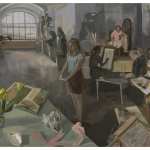In the NY Times, Roberta Smith, writes a short essay on the state of contemporary painting in which she suggests not only that ranking art mediums and declaring some of them (like painting) dead is finally pass�, but that painters are approaching the medium more freely than ever. “Few modern myths about art have been as persistent or as annoying as the so-called death of painting. Unless, of course, it is the belief that abstract and representational painting are oil and water, never to meet as one. The two notions are related. The Modernist insistence on the separation of representation and abstraction robbed painting of essential vitality. Both notions have their well-known advocates. And both, in my mind seem, well, very 20th century.
“There have been moments of dazzling balance between the representational and the abstract � for example, Byzantine mosaics; pre-Columbian and American Indian textiles and ceramics; Japanese screens; Mughal painting; and post-Impressionism. Painting may be in a similar place right now, fomented mostly, but not always, by young painters who have emerged in the last decade. They feel freer to paint what they want than at any time since the 1930s, or maybe even the 1890s, when post-Impressionism was at its height. In the late 19th century painting was being radically changed by a series of artistic explosions � the newly abstracted figuration of post-Impressionists from van Gogh to Ensor; the extremes of color favored by the Fauves, like the young Matisse, and German Expressionists, like Kirchner; the shattering of representational form by Cubism and Futurism; and finally the flowering of abstraction itself in the work of Malevich and Mondrian.
“By the 1970s, thanks largely to formalist critics like Clement Greenberg and Donald Judd, painting had been flattened and emptied of figures, subject matter and illusionistic space….But with each generation of painters, the authority of Greenberg and Judd pales while the history of the pictorial expands, revealing new possibilities for scholars, curators and artists alike….
“But what really is questionable, and pass�, is the implied ranking of art mediums and the leaving of some of them for dead. None of them ever really, ultimately have much of a monopoly on quality. And something else greatly reduces the chances of the death of painting: too many people � most obviously women � are just beginning to make their mark with the medium and are becoming active in its public dialogue….”
Check out Smith’s slide show of contemporary figure painting here.

















Hi Joanne,
This post reminds me of something I just heard recently — namely that there will be a kind of "festival of painting" in Montreal this summer. From what I understand, it will focus on some of Canada's younger "maximalist" painters like Kim Dorland (you can see some of his work here… http://www.blogto.com/artists/kim_dorland/)
I don't seen any official festival website set up yet, but if I hear more I will let you know.
I can't help but feel that this kind of attention can only dilute what ever good has been happening in painting recently. Seems the greatest leaps forward only happen when the practice of painting is disparaged and marginalized. When it becomes "glamorous" a lot of crap gets passed off as profound. Don't believe me, just look at the 80s.
ditto, I'm a little unnerved by celebrations of painting.To paraphrase and completely pervert Greenberg, a painting must be able to hold its own in terms of quality against the very best of conceptual art.
The Churchman sort of reminded me of Joan Brown – maybe it was the cat?
As a (slide) show this didn't do it for me. Smith's little historical capsule didn't quite fill the bill either.
But yeah the abstract and the figurative are no longer so easily separated. Painting deals in this as convincingly as print forms, digital or analog. The neo Neo-Ex is really looking for that halfway house between painterliness and picture content. There's a heap of this everywhere.
The big question, it seems to me, is where you take the content from? – I think the issue gets a lot livelier when there's more at stake than family pets, fabric design or old masks.
But that's just me.
Is there a reason why this post consists almost entirely of Roberta's essay when we could just read it at the end of the link provided?
Anyway. A number of people have already been discussing this over at Franklin's. Most commenters there concluded that Roberta's slideshow collects some of the worst painting imaginable at this point in time. If this is her evidence that painting isn't dead, maybe it should be.
Further, I pointed out there — and want to point out here, too — that Roberta wrote very much the same essay in 2002. And her slideshow from eight years ago is just as bad as the current one.
Not only that Chris, but John Haber is also having this conversation.
Why does everyone obsess about Roberta�s views? Just because they�re in the NYT?
At Franklin's we tend to gnaw over articles from various art critics from time to time. Jerry Saltz is often on the table, and Schjeldahl and Plagens. Recently we've discussed Roger Scruton too. We've been banging on Roberta lately and the Times in general. The commenters there usually look very unfavorably on the exudations of Holland Cooter [sic].
Obviously Roberta's important because she's in the New York Times. She's got a big platform from which she declares the resurrection of painting every few years, apparently.